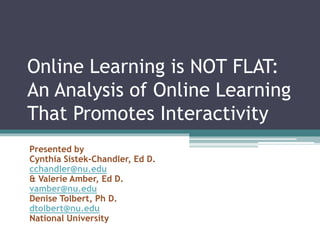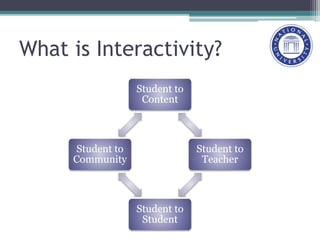Interactive Learning: AECT Presentation
- 1. Online Learning is NOT FLAT: An Analysis of Online Learning That Promotes Interactivity Presented by Cynthia Sistek-Chandler, Ed D. [email protected] & Valerie Amber, Ed D. [email protected] Denise Tolbert, Ph D. [email protected] National University
- 2. Interactive Learning Taxonomy Applied in an Online Course • Introduction and Overview • Background of Taxonomy • Key Points • Structure of Taxonomy • EDT 610 Course Description • Study Design • Analysis of Interactive Taxonomy for Learning • Preliminary Data • References
- 3. Introduction and Overview The overarching goal of this study is to examine the application of a theoretical taxonomy for learning in an online environment.
- 4. Quickwrite Identify strategies you use to promote interactivity in your teaching environment.
- 5. What is the ILT? The ILT is a dynamic relationship between teacher and students, between students and resources, and among students.
- 6. Key Points of the ILT • Interactive Learning = F-2-F & online classes • Encompasses all content areas and all dimensions of learning. • Interactive learning can be used at any age level from infancy to maturity, and throughout life.
- 7. Key Points • Online interactive learning, by its nature includes the learner in the process of learning and requires interactivity, not passivity. • Without interactivity, students are not engaged and are not learners. Spring Symosium, National University
- 8. Background of Taxonomy • The Interactive Learning Taxonomy (ILT) was first published in Steinaker and Leavitt (2008). ▫ Steinaker, N. & Leavitt, L. (2008). Interactive Learning: The Art and Science of Teaching. Kendall Hunt Publishing: Iowa (page XV).
- 9. What is Interactivity? Student to Content Student to Teacher Student to Student Student to Community
- 10. Structure of Taxonomy Interactive TaxonomyInvitation Involvement Investigation Insight Implementation
- 11. Engaging Framing Reframing Invitation “The instructor has obviously taken a great deal of time to find eye catching and topic appropriate graphics, a pleasing layout as well as exceptional sites that will be of interest to her students. She also provides an invitation to her students in her welcome.”
- 12. Chosen learning experience Dialogue and discussion Refraining Involvement How does the lesson involve the learner with the content? “The lesson involves the learner by allowing the learner to interact with the technology. The learner can move through the presentation of the cell cycle at his/her own pace. Students can navigate forward and back in order to master concepts presented in the lesson.”
- 13. Direct instruction Group work Moderator and resolver Leadership Investigation “In the investigation phase, students have already participated in the lesson; they must then branch out and explore other avenues of the given topic.” “At the end of the “Mitosis and The Cell Cycle” lesson, in the “Post” section, Lee (2008) allows her students to investigate.”
- 14. Goals Challenges Insight “Students gain insight when they are able to comprehend and complete the goals and objectives that the teacher detailed at the start of the lesson. Lee’s students demonstrate their insight of the material in the “Questions & Assignment” section of the lesson.”
- 15. Dissemination Critique and consult Students are self-motivated Implementation “Students are encouraged to identify trends and to forecast possibilities. Students are invited to apply their existing knowledge in the generation of new ideas and processes.” “The students are tasked to use simulations and models to explore.”
- 16. EDT 610 Course Description • Teaching Online (EDT 610) Teaching Teachers how to teach in an Online Environment • National University, Masters of Arts in Teaching, 5-course Specialization in Educational Technology • ILT allows students to contextualize many aspects of teaching and learning that are often missing from teacher education programs. Spring Symosium, National University
- 17. Study Design • Action Research • Students build an online Blog lesson • Application of taxonomy by students in EDT 610 • Data Collection- 4 classes • Analysis of their application and reflections
- 18. Interactive Lesson EDT 610 http://cindiklee.blogspot.com/ Developed by Cindi K. Lee Spring Symosium, National University
- 19. Research Application and analysis levels are critical to cognition (Bloom, 1956). Discourse and discussion are central to investigation. ▫ Group interaction among peers online ▫ Practice and apply analysis through synchronous discussion Spring Symosium, National University
- 20. Preliminary Data • Theoretical construct applied • Reflection, thinking, and cognition ▫ Analysis and reflection ▫ Metacognitive • Data collection is ongoing
- 21. Interactive Learning As human learners, we need dialogue and written communication to process ideas and to exchange perspectives. Discourse and discussion (both synchronous and asynchronous) in an online environment transforms learning.
- 22. Interactivity not passivity Without interactivity there is no engagement Instructional Design can drive the level of interactivity
- 23. References Baldwin, L., & Sabry, K. (2003, November). Learning styles for interactive learning systems. Innovations in Education & Teaching International, 40(4), 325-340. Retrieved January 22, 2009, doi:10.1080/1470329032000128369 Cassarino, C. (2003, Winter2003). INSTRUCTIONAL DESIGN PRINCIPLES FOR AN eLEARNING ENVIRONMENT. Quarterly Review of Distance Education, 4(4), 455-461. Retrieved January 22, 2009, from Academic Search Premier database. Davies, P. & Dunnill, R. (2008). 'Learning Study' as a model of collaborative practice in initial teacher education. Journal of Education for Teaching, 34(1), 3. Retrieved March 22, 2009, from ProQuest Education Journals database. (Document ID: 1467191401). Ma, Y., Lai, G. Williams, D., Prejean, L. Ford, M. (2008). Exploring the Effectiveness of a Field Experience Program in a Pedagogical Laboratory: The Experience of Teacher Candidates. Journal of Technology and Teacher Education, 16(4), 411-431. Retrieved March 22, 2009, from ProQuest Education Journals database. (Document ID: 1653161271).
- 24. References Mitsuhara, H., Kanenishi, K., & Yano, Y. (2006, May). Adaptive link generation for multiperspective thinking on the Web: an approach to motivate learners to think. Innovations in Education & Teaching International, 43(2), 137-149. Retrieved January 22, 2009, doi:10.1080/14703290600650434 Sims, R. (2003b) ‘Promises of interactivity: aligning learner perceptions and expectations with strategies for open and flexible learning’, Distance Education, 24(1), 87–103. Steinaker, N. & Leavitt, L. (2008). Interactive Learning: The Art and Science of Teaching. Kendall Hunt Publishing: Iowa. Xin, C. & Feenberg, A. (2006). Pedagogy in Cyberspace: The Dynamics of Online Discourse. Journal of Distance Education, 21(2), 1-25. Retrieved March 22, 2009, from Education Module database. (Document ID: 1255253831).
Editor's Notes
- #3: Introduction and Overview Background of Taxonomy Key Points Structure of Taxonomy EDT 610 Course Description Study Design Analysis of Interactive Taxonomy for Learning Preliminary Data References
- #4: Define and describe “interactivity” in the classroom.
- #7: You may agree that we learn best in settings where we can relate to one another and to the resources available to us.
- #12: The instructor has obviously taken a great deal of time to find eye catching and topic appropriate graphics, a pleasing lay out as well as exceptional sites that will be of interest to her students. She also provides an invitation to her students in her welcome. Each assignment has interesting topics and opportunities to learn online as well as communicate with their classmates with comments and website recommendations.
- #14: In the investigation phase, students have already participated in the lesson; they must then branch out and explore other avenues of the given topic. Lee (2008) allows her students to investigate at the end of the “Mitosis and The Cell Cycle” lesson, in the “Post” section. She writes, “Once you complete the questions above and the flow map, perform a search on the Internet to find a helpful website on this topic. Post the website address and provide a brief summary of why you chose it.” Students must explore the topic of mitosis and the cell cycle by searching the Internet for valuable websites. This will provide students with more knowledge regarding this topic; moreover, because students have to compose a summary, they will be required to thoroughly examine their website, as opposed to simply copying and pasting a URL. Finally, because students have to post their website summaries, it seems that they are sharing their information with their classmates. In order to facilitate more investigation, Lee may consider detailing how students should respond to each other’s posts. This will increase students’ interaction.
- #20: Application and analysis levels are critical to cognition (Bloom, 1956). Discourse and discussion are central to investigation. Group interaction among peers online Practice and apply analysis through synchronous discussion
- #21: Invitation for students to analyze a lesson created by a peer Involvement Investigation Insight Implementation
- #23: Online interactive learning, by its nature includes the learner in the process of learning and requires interactivity, not passivity. Without interactivity, students are not engaged and are not learners.
























